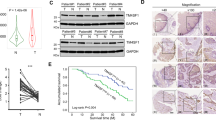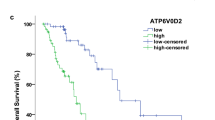Abstract
Purpose
We investigated expression of TM4SF5 and its involvement in human esophageal cancer (HEC).
Methods
We analyzed TM4SF5 expression in normal esophageal epithelial cells (HEEC), in four HEC cell lines, and in 20 HEC clinical tissue samples and matched nontumor samples. The effect of TM4SF5 on HEC cell proliferation and metastasis and invasion was assessed, and the relationship between TM4SF5 and integrin β1 was determined. Finally, TM4SF5 and integrin β1 expression were further examined by use of immunohistochemistry (IHC) and tissue microarray analysis, and the prognostic use of TM4SF5 and integrin β1 in HEC was evaluated.
Results
TM4SF5 was more highly expressed in HEC cells and in HEC tissues than in HEEC and matched nontumor tissues. Down-regulation of TM4SF5 in KYSE150 cells reduced cell proliferation and metastasis and invasion whereas metastasis and invasion by KYSE510 increased after TM4SF5 cDNA transfection. In HEC cells, TM4SF5 formed a complex with integrin β1, and interference with integrin β1 in KYSE510-TM4SF5 cells markedly inhibited cell invasion on laminin 5. Our findings also showed that TM4SF5 and integrin β1 overexpression correlated with low differentiation and high stage (p < 0.05, respectively). Postoperative 5-year overall survival of patients with TM4SF5low and/or integrin β1low was higher than for patients with TM4SF5high and/or integrin β1high. Multivariate analysis demonstrated that TM4SF5 and integrin β1 co-overexpression was an independent prognostic marker for HEC.
Conclusion
TM4SF5 is positively associated with HEC invasiveness. The combination of TM4SF5 with integrin β1 could potentially serve as a novel marker for predicting HEC prognosis.





Similar content being viewed by others
Abbreviations
- HEC:
-
Human esophageal cancer
- ESCC:
-
Esophageal squamous cell carcinoma
- HEEC:
-
Human normal esophageal epithelial cells
- TM4SF5:
-
Four-transmembrane L6 family member 5
- TMA:
-
Tissue microarray
- IHC:
-
Immunohistochemistry
- GAPDH:
-
Glyceraldehyde 3-phosphate dehydrogenase
- RT-PCR:
-
Reverse transcription-polymerase chain reaction
- OS:
-
Overall survival
- TEM:
-
Tetraspanin-enriched membrane microdomain
- DMEM:
-
Dulbecco’s modified Eagle’s medium
- HCC:
-
Hepatocellular carcinoma
References
Siegel R, Naishadham D, Jemal A. Cancer statistics. CA Cancer J Clin. 2012;62:10–29.
Siegel R, Desantis C, Virgo K, et al. Cancer treatment and survivorship statistics, 2012. CA Cancer J Clin. 2012;62:220–241.
Rouvelas I, Zeng W, Lindblad M, Viklund P, Ye W, Lagergren J. Survival after surgery for oesophageal cancer: a population-based study. Lancet Oncol. 2005;6:864–870.
Mariette C, Balon JM, Piessen G, Fabre S, Van Seuningen I, Triboulet JP. Pattern of recurrence following complete resection of esophageal carcinoma and factors predictive of recurrent disease. Cancer. 2003;97:1616–1623.
Ohigashi Y, Sho M, Yamada Y, et al. Clinical significance of programmed death-1 ligand-1 and programmed death-1 ligand-2 expression in human esophageal cancer. Clin Cancer Res. 2005;11:2947–2953.
Hemler ME. Tetraspanin functions and associated microdomains. Nat Rev Mol Cell Biol. 2005;6:801–811.
Hemler ME. Targeting of tetraspanin proteins–potential benefits and strategies. Nat Rev Drug Discov. 2008;7:747–758.
Levy S, Shoham T. The tetraspanin web modulates immune-signalling complexes. Nat Rev Immunol. 2005;5:136–148.
Lee SA, Park KH, Lee JW. Modulation of signaling between TM4SF5 and integrins in tumor microenvironment. Front Biosci. 2011;16:1752–1758.
Wright MD, Ni J, Rudy GB. The L6 membrane proteins–a new four-transmembrane superfamily. Protein Sci. 2000;9:1594–1600.
Stipp CS, Kolesnikova TV, Hemler ME. Functional domains in tetraspanin proteins. Trends Biochem Sci. 2003;28:106–112.
Lee SA, Kim YM, Kwak TK, et al. The extracellular loop 2 of TM4SF5 inhibits integrin alpha2 on hepatocytes under collagen type I environment. Carcinogenesis. 2009;30:1872–1879.
Kaneko R, Tsuji N, Kamagata C, et al. Amount of expression of the tumor-associated antigen L6 gene and transmembrane 4 superfamily member 5 gene in gastric cancers and gastric mucosa. Am J Gastroenterol. 2001;96:3457–3458.
Lee SA, Kim TY, Kwak TK, et al. Transmembrane 4 L six family member 5 (TM4SF5) enhances migration and invasion of hepatocytes for effective metastasis. J Cell Biochem. 2010;111:59–66.
Lee SA, Lee SY, Cho IH, et al. Tetraspanin TM4SF5 mediates loss of contact inhibition through epithelial-mesenchymal transition in human hepatocarcinoma. J Clin Invest. 2008;118:1354–1366.
Li B, Li YY, Tsao SW, Cheung AL. Targeting NF-kappaB signaling pathway suppresses tumor growth, angiogenesis, and metastasis of human esophageal cancer. Mol Cancer Ther. 2009;8:2635–2644.
Ke AW, Shi GM, Zhou J, et al. Role of overexpression of CD151 and/or c-Met in predicting prognosis of hepatocellular carcinoma. Hepatology. 2009;49:491–503.
Hu YC, Lam KY, Law S, Wong J, Srivastava G. Profiling of differentially expressed cancer-related genes in esophageal squamous cell carcinoma (ESCC) using human cancer cDNA arrays: overexpression of oncogene MET correlates with tumor differentiation in ESCC. Clin Cancer Res. 2001;7:3519–3525.
Huang XY, Shi GM, Devbhandari RP, et al. Low level of low-density lipoprotein receptor-related protein 1 predicts an unfavorable prognosis of hepatocellular carcinoma after curative resection. PLoS One. 2012;7:e32775.
Devbhandari RP, Shi GM, Ke AW, et al. Profiling of the tetraspanin CD151 web and conspiracy of CD151/integrin beta1 complex in the progression of hepatocellular carcinoma. PLoS One. 2011;6:e24901.
Richardson MM, Jennings LK, Zhang XA. Tetraspanins and tumor progression. Clin Exp Metastasis. 2011;28:261–270.
Karlsson E, Delle U, Danielsson A, et al. Gene expression variation to predict 10-year survival in lymph-node-negative breast cancer. BMC Cancer. 2008;8:254.
Lee SA, Ryu HW, Kim YM, et al. Blockade of four-transmembrane L6 family member 5 (TM4SF5)-mediated tumorigenicity in hepatocytes by a synthetic chalcone derivative. Hepatology. 2009;49:1316–1325.
Yanez-Mo M, Barreiro O, Gordon-Alonso M, Sala-Valdes M, Sanchez-Madrid F. Tetraspanin-enriched microdomains: a functional unit in cell plasma membranes. Trends Cell Biol. 2009;19:434–446.
Charrin S, Manie S, Billard M, et al. Multiple levels of interactions within the tetraspanin web. Biochem Biophys Res Commun. 2003;304:107–112.
Yunta M, Lazo PA. Tetraspanin proteins as organisers of membrane microdomains and signalling complexes. Cell Signal. 2003;15:559–564.
Huang XY, Ke AW, Shi GM, et al. Overexpression of CD151 as an adverse marker for intrahepatic cholangiocarcinoma patients. Cancer. 2010;116:5440–5451.
Odintsova E, Voortman J, Gilbert E, Berditchevski F. Tetraspanin CD82 regulates compartmentalisation and ligand-induced dimerization of EGFR. J Cell Sci. 2003;116:4557–4566.
Ke AW, Shi GM, Zhou J, et al. CD151 amplifies signaling by integrin alpha6beta1 to PI3K and induces the epithelial-mesenchymal transition in HCC cells. Gastroenterology. 2011;140:1629–1641e1615.
Acknowledgments
This work was supported by the National Natural Science Foundation of China (81260321, 309603381) and the National Natural Science Foundation of Hainan Province (No. 811206).
Conflict of interest
None.
Author information
Authors and Affiliations
Corresponding author
Additional information
Yong-bing Wu, You-sheng Huang, Ya-ping Xu, and Yu-fang Sun contributed equally to the work.
Rights and permissions
About this article
Cite this article
Wu, Yb., Huang, Ys., Xu, Yp. et al. A High Level of TM4SF5 Is Associated with Human Esophageal Cancer Progression and Poor Patient Survival. Dig Dis Sci 58, 2623–2633 (2013). https://doi.org/10.1007/s10620-013-2690-1
Received:
Accepted:
Published:
Issue Date:
DOI: https://doi.org/10.1007/s10620-013-2690-1




